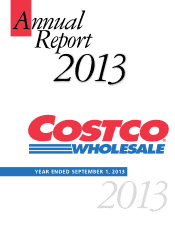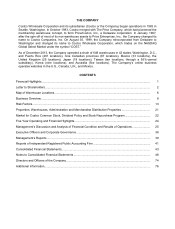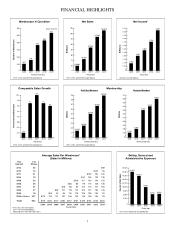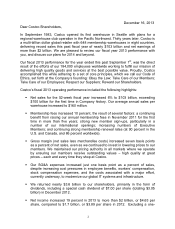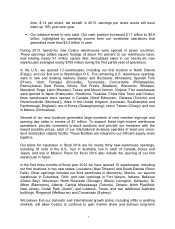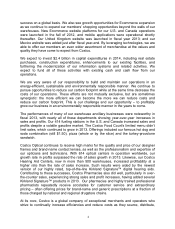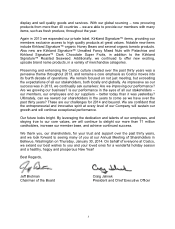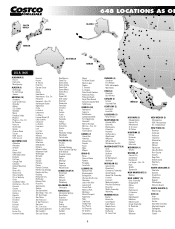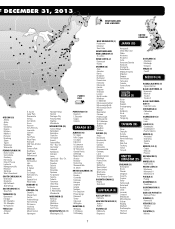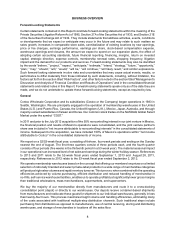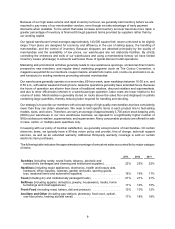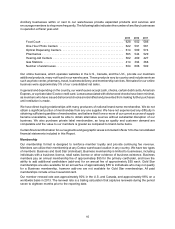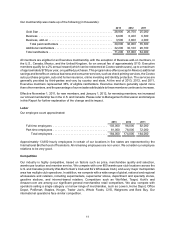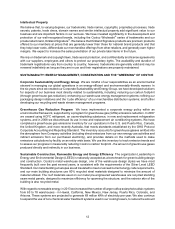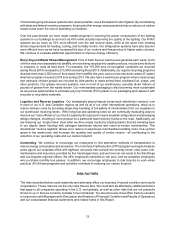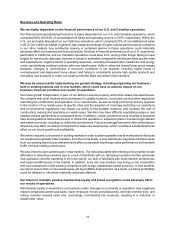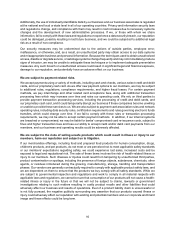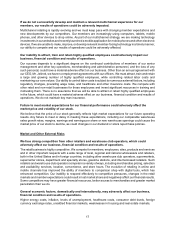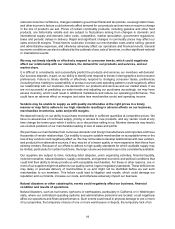Costco 2013 Annual Report Download - page 10
Download and view the complete annual report
Please find page 10 of the 2013 Costco annual report below. You can navigate through the pages in the report by either clicking on the pages listed below, or by using the keyword search tool below to find specific information within the annual report.8
BUSINESS OVERVIEW
Forward-Looking Statements
Certain statements contained in this Report constitute forward-looking statements within the meaning of the
Private Securities Litigation Reform Act of 1995, Section 27A of the Securities Act of 1933, and Section 21E
of the Securities Exchange Act of 1934. They include statements that address activities, events, conditions
or developments that we expect or anticipate may occur in the future and may relate to such matters as
sales growth, increases in comparable store sales, cannibalization of existing locations by new openings,
price or fee changes, earnings performance, earnings per share, stock-based compensation expense,
warehouse openings and closures, the amount we expect to spend on our expansion plans, the effect of
adopting certain accounting standards, future financial reporting, financing, margins, return on invested
capital, strategic direction, expense controls, membership renewal rates, shopping frequency, litigation
impact and the demand for our products and services. Forward-looking statements may also be identified
by the words “believe,” “project,” “expect,” “anticipate,” “estimate,” “intend,” “strategy,” “future,” “opportunity,”
“plan,” “may,” “should,” “will,” “would,” “will be,” “will continue,” “will likely result,” and similar expressions.
Such forward-looking statements involve risks and uncertainties that may cause actual events, results, or
performance to differ materially from those indicated by such statements, including, without limitation, the
factors set forth in the section titled “Risk Factors”, and other factors noted in the section titled “Management's
Discussion and Analysis of Financial Condition and Results of Operations” and in the consolidated financial
statements and related notes in this Report. Forward-looking statements speak only as of the date they are
made, and we do not undertake to update these forward-looking statements, except as required by law.
General
Costco Wholesale Corporation and its subsidiaries (Costco or the Company) began operations in 1983 in
Seattle, Washington. We are principally engaged in the operation of membership warehouses in the United
States (U.S.) and Puerto Rico, Canada, the United Kingdom (U.K.), Mexico, Japan, Australia, and through
majority-owned subsidiaries in Taiwan and Korea. Our common stock trades on the NASDAQ Global Select
Market under the symbol “COST.”
In 2011 and prior to the July 2012 acquisition of the 50% noncontrolling interest in our joint venture in Mexico,
the financial position and results of Mexico's operations were consolidated, and the joint venture partner's
share was included in "net income attributable to noncontrolling interests" in the consolidated statements of
income. Subsequent to the acquisition, we have included 100% of Mexico's operations within "net income
attributable to Costco" in the consolidated statements of income.
We report on a 52/53-week fiscal year, consisting of thirteen, four-week periods and ending on the Sunday
nearest the end of August. The first three quarters consist of three periods each, and the fourth quarter
consists of four periods (five weeks in the thirteenth period in a 53-week year). The material seasonal impact
in our operations is an increased level of net sales and earnings during the winter holiday season. References
to 2013 and 2011 relate to the 52-week fiscal years ended September 1, 2013 and August 28, 2011,
respectively. References to 2012 relate to the 53-week fiscal year ended September 2, 2012.
We operate membership warehouses based on the concept that offering our members low prices on a limited
selection of nationally branded and select private-label products in a wide range of merchandise categories
will produce high sales volumes and rapid inventory turnover. This turnover, when combined with the operating
efficiencies achieved by volume purchasing, efficient distribution and reduced handling of merchandise in
no-frills, self-service warehouse facilities, enables us to operate profitably at significantly lower gross margins
than traditional wholesalers, mass merchandisers, supermarkets, and supercenters.
We buy the majority of our merchandise directly from manufacturers and route it to a cross-docking
consolidation point (depot) or directly to our warehouses. Our depots receive container-based shipments
from manufacturers and reallocate these goods for shipment to our individual warehouses, generally in less
than twenty-four hours. This process maximizes freight volume and handling efficiencies, eliminating many
of the costs associated with traditional multiple-step distribution channels. Such traditional steps include
purchasing from distributors as opposed to manufacturers, use of central receiving, storing and distributing
warehouses, and storage of merchandise in locations off the sales floor.

